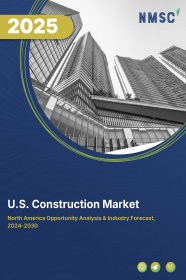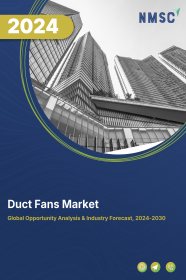
U.S. Construction Market by Type (Renovation and New Construction), and by Sector (Real Estate, Infrastructure, and Industrial)–Opportunity Analysis and Industry Forecast, 2024–2030
Industry: Construction & Manufacturing | Publish Date: 18-Jan-2025 | No of Pages: 143 | No. of Tables: 108 | No. of Figures: 53 | Format: PDF | Report Code : CM2194
US Tariff Impact on U.S. Construction Market
Trump Tariffs Are Reshaping Global Business
U.S. Construction Market Overview
The U.S. Construction Market size was valued at USD 1.77 trillion in 2023, and is predicted to reach USD 2.52 trillion by 2030, at a CAGR of 4.0% from 2024 to 2030.
The construction market, also known as infrastructure market, plays an essential role in the economy by overseeing the entire process from initial planning to ongoing maintenance of various physical structures, including infrastructure, buildings, and facilities. This sector is involved in a wide range of projects, spanning residential, commercial, industrial, civil engineering, and institutional infrastructure developments.
It engages numerous stakeholders, including architects, engineers, contractors, suppliers, developers, investors, and government agencies. The industry is poised for growth, fueled by an increased focus on environmentally friendly practices such as the use of green building materials and energy-efficient designs. Additionally, factors such as rising per capita income in emerging economies and low-interest rates in developed countries are expected to further drive the expansion of the infrastructure market.
Large-Scale Project Investments Drive Growth in the Construction Sector
The construction market in this country is experiencing substantial growth, primarily fueled by a surge in large-scale project investments and infrastructure development. For instance, notable megaprojects in the industry in 2023 included the Southeast Connector Project in the Dallas-Fort Worth Area, Madison Square Garden Sphere in Las Vegas, NV, Gordie Howe International Bridge in Detroit, MI, American Legion Bridge Replacement in Bethesda, MD, Related Santa Clara Project in Santa Clara, CA, Hudson Tunnel Project in New York City, NY, and JFK Airport Expansion in New York City, NY. These significant projects play a crucial role in expanding the market in the country.
Government-Led Infrastructure Initiatives Propel Expansion of the Construction Industry
Moreover, the construction market in the U.S. is currently undergoing significant expansion, driven by a growing number of government-led initiatives aimed at developing new infrastructure projects. These projects span various areas, including transportation infrastructure such as roads, bridges, and airports. In 2023, the U.S. government allocated over USD 220 billion to support more than 32,000 projects across 4,500 communities in all 50 states, the District of Columbia, and U.S. territories. This funding aims to revitalize and modernize the country's infrastructure, replace lead pipes, address pollution, expand affordable high-speed internet access, and facilitate the transition to clean energy.
Navigating Regulatory Complexities Hinders Growth in the Infrastructure Market
The construction market faces significant challenges stemming from stringent regulatory frameworks. Infrastructure ventures encounter hurdles due to the complex network of government regulations and permitting processes. Infrastructure projects typically require securing numerous permits and approvals from governmental bodies at local, regional, and national levels. These permissions encompass zoning regulations, environmental assessments, compliance with building codes, safety standards, and various regulatory requirements.
Lengthy permit acquisition processes, bureaucratic inefficiencies, and regulatory disparities among jurisdictions can significantly prolong project timelines and inflate costs. Additionally, fluctuations in regulations or unexpected policy changes can disrupt ongoing projects and discourage potential investments. For instance, the United States Environmental Protection Agency (EPA) oversees various aspects of the infrastructure sector, including air quality, lead management, waste disposal, and water regulations. The EPA's compliance assistance centers offer resources to facilitate environmental compliance during demolition activities, the recycling of infrastructure materials, and the proper disposal of refrigeration and air-conditioning equipment.
Integration of Digitalization and BIM Presents Lucrative Opportunity for Market Expansion
The market is undergoing a significant transformation with the integration of digitalization and the adoption of Building Information Modeling (BIM), harnessing advanced technologies to enhance efficiency, accuracy, and collaboration across various projects. BIM, an advanced 3D modeling tool, empowers stakeholders to generate and oversee digital renditions of structures and infrastructure, facilitating improved coordination and communication among project teams.
For example, in September 2022, the National Institute of Building Sciences (NIBS) launched the U.S. National Building Information Management (BIM) Program, aiming to revolutionize the infrastructure industry and achieve unprecedented levels of industrial efficiency through digitalization. This initiative addresses the insufficient degree of digitalization within the U.S. infrastructure sector, impedes the evolution of lifecycle work processes to become more efficient, cost-effective, resilient, and safer for infrastructure and maintenance.
Competitive Landscape
The market players operating in the U.S. infrastructure industry include Lennar Corp., D.R. Horton, Inc., PulteGroup, Inc., Jacobs Engineering, Fluor Corporation, AECOM, NVR, Inc., Toll Brothers, KBR, Primoris Services Corporation,McCarthy Building Companies, Inc, Balfour Beatty, Inc, Skanska USA Inc, Holder Construction Group, LLC, STO Building Group Inc and others.
U.S. Construction Market Key Segments
By Type
-
Renovation
-
New Construction
By Sector
-
Real Estate
-
Residential
-
Affordable
-
Luxury
-
-
Commercial
-
-
Retail Buildings
-
Office Buildings
-
Hospitality
-
Healthcare Facilities
-
Educational Institutes
-
Entertainment Ventures
-
-
Infrastructure
-
Transportation
-
Airport
-
Port
-
Rail
-
Road
-
-
Water and Wastewater
-
Energy
-
Telecommunication
-
-
Industrial
-
Manufacturing Plant
-
Warehouses
-
Power Plants
-
Oil Refineries
-
Chemical Plants
-
Key Players
-
Lennar Corp.
-
D.R. Horton, Inc.
-
PulteGroup, Inc.
-
Jacobs Engineering
-
Fluor Corporation
-
AECOM
-
NVR, Inc.
-
Toll Brothers
-
KBR
-
Primoris Services Corporation
-
McCarthy Building Companies, Inc
-
Balfour Beatty, Inc
-
Skanska USA Inc
-
Holder Construction Group, LLC
-
STO Building Group Inc
REPORT SCOPE AND SEGMENTATION:
|
Parameters |
Details |
|
Market Size in 2023 |
USD 1.77 Trillion |
|
Revenue Forecast in 2030 |
USD 2.52 Trillion |
|
Growth Rate |
CAGR of 4.0% from 2024 to 2030 |
|
Analysis Period |
2023–2030 |
|
Base Year Considered |
2023 |
|
Forecast Period |
2024–2030 |
|
Market Size Estimation |
Trillion (USD) |
|
Growth Factors |
|
|
Companies Profiled |
15 |
|
Market Share |
Available for 10 companies |
|
Customization Scope |
Free customization (equivalent up to 80 working hours of analysts) after purchase. Addition or alteration to country, regional, and segment scope. |
|
Pricing and Purchase Options |
Avail customized purchase options to meet your exact research needs. |

















 Speak to Our Analyst
Speak to Our Analyst

















